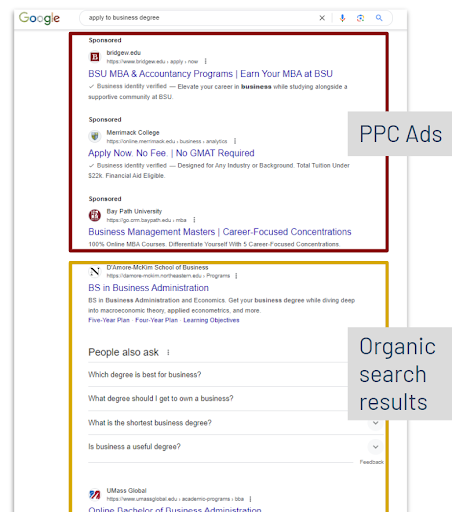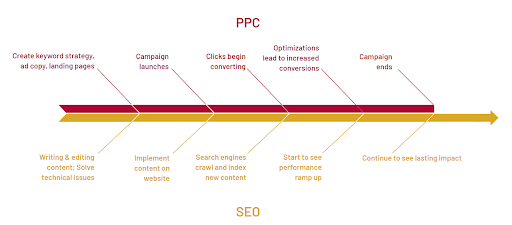 Sep 16, 2024
Persona
Sep 16, 2024
Persona
In today’s digital age, higher education institutions face increasing competition to attract prospective students. While many higher ed marketers wonder if they should focus on Pay-Per-Click (PPC) campaigns or Search Engine Optimization (SEO), the truth is that you should consider an integrated Search Engine Marketing (SEM) strategy combining the strengths of both tactics.
With over 80% of students using search engines to find information about colleges and programs, understanding and leveraging the power of SEM is crucial. When you strategically utilize SEO and PPC advertising together, you can significantly enhance visibility and drive high-quality leads for your college or university.
Let’s explore the importance of SEO and PPC and how they can boost the results of your institution’s marketing campaigns.
Table of Contents:
- Understanding SEO and PPC Strategies
- SEO vs. PPC: What Are Their Unique Features?
- The Benefits of Leveraging SEO and PPC Together
- What Does an Effective SEM Campaign Look Like in Higher Ed?
- Five Ways SEO and PPC Strategies Work Together
- AI: The Future of SEM in Higher Education
Understanding SEO and PPC Strategies
SEO involves optimizing your website’s technical elements and improving website content and user experience so that your institution is more visible in search engines such as Google. This organic growth strategy helps institutions earn “free” traffic by appearing in organic search results when prospective students search with relevant key phrases.
PPC Advertising, on the other hand, is a strategy where advertisers pay each time users click on the ad. Paid search ads appear at the top of search engine results pages (SERPs) when users search for specific keywords. This method allows institutions to reach specific audiences and immediately drive traffic to their websites and future students into the admissions funnel.
The image below shows an example of the search results page where PPC ads typically appear at the top, followed by organic search results.

SEO vs. PPC: What Are Their Unique Features?
While both SEO and PPC aim to increase visibility and drive website traffic, they each have unique characteristics and benefits. Here’s a comparison to help you understand how they differ and how they can complement each other:
| FEATURE | SEO | PPC |
|---|---|---|
| Cost | Generally “free” organic traffic but requires investment in content creation and technical optimization. | Paid traffic; costs depend on the competitiveness of the keywords and search demand. |
| Time to Results | Takes time to build up (usually several months) but provides long-term benefits. | Can generate immediate traffic and conversions as soon as the campaign is live. |
| Sustainability | Provides ongoing traffic and visibility even after the campaign ends. | Traffic and conversions stop when the campaign is paused or the budget runs out. |
| Visibility | Achieves visibility through organic search rankings, featured snippets, and AI search results. | Appears at the top of SERPs, above organic results, and can include ad extensions. |
| Conversion Rate | Typically higher conversion rates for organic traffic due to user trust and intent. | High conversion rates for targeted campaigns, especially for high-intent keywords. |
| Control | Less direct control over rankings; depends on content quality and search engine algorithms. | Full control over ad copy and extensions, budget, keyword selection, and more. |
The Benefits of Leveraging SEO and PPC Together
Wondering why you should implement a comprehensive SEM strategy for your college? When SEO and PPC are used together, they create a powerful synergy that can significantly boost your higher education institution’s online presence. Here are some major benefits:
- Increased Visibility and Brand Awareness: By combining SEO and PPC, institutions can dominate SERPs with both organic and paid listings. This increased visibility not only enhances brand awareness but also builds credibility and trust among prospective students and other target audiences.
- Improved Click-Through Rates (CTR): Studies show that having both organic and paid listings on the same SERP can improve the overall CTR. Prospective students are more likely to click on your link when they see your institution in both organic and paid results.
- Cost-Effective Marketing: While PPC ads yield results quickly, SEO builds a sustainable source of organic traffic over time. Together, they create a balanced marketing strategy that maximizes return on investment (ROI).
- Keyword Strategy Optimization: SEO and PPC teams can collaborate on keyword research and share insights. This collaboration ensures that the most effective and relevant keywords are targeted across both strategies, improving overall campaign performance.
Consider this example of one of Carnegie’s partners, a private religious university in Louisiana. By integrating their SEO and PPC efforts, they saw a 138% increase in total paid conversions and a 159% increase in organic traffic.
What Does an Effective SEM Campaign Look Like in Higher Ed?
To help you visualize a cohesive Search Engine Marketing campaign, we created an infographic below.

Your institution’s search engine marketing campaign begins with your SEO and PPC teams developing keyword strategies, creating website content and campaign landing pages, and solving website technical issues. Next, your PPC campaign can launch while you implement SEO content onto your website.
As PPC drives immediate results, your clicks soon begin to convert. SEO strategy, on the other hand, will take a few weeks to start generating traffic because it needs to wait for search engines to index the new content on your website. While waiting for your organic traffic to ramp up, your PPC team may work on optimizing your campaign to increase conversions.
When your PPC campaign ends, the ads will stop generating direct clicks and leads. However, SEO is an always-on marketing strategy that continues to funnel traffic to your website and supplements on-site conversions.
Five Ways SEO and PPC Strategies Work Together for Better Traffic and Conversions
Now that you understand the advantages of a cohesive Search Engine Marketing strategy, your next question might be, “How do I implement SEO and PPC strategies in my university’s marketing plan?”
Here are five ways you can start orchestrating your SEO and PPC efforts to achieve your marketing and enrollment goals through Search Engine Marketing.
1. Align Messaging and Branding
The first step to executing your SEO and PPC collaboration is to ensure branding is consistent and cohesive across both campaigns. Consider your target audience and what your brand voice should be to engage with your prospects. By infusing your brand personality into your ads and web content, you can differentiate yourself from other institutions.
In addition, streamline your messaging. For example, you can highlight the same unique selling points in your PPC ads and on your website. Make sure the information does not contradict each other across channels. This way, you build trust with your audience, which leads to better conversion rates.
Start learning more about developing a branding strategy for your institution.
2. SEO the Web Pages that Your PPC Ads Drive Traffic to
The next step is finding out which pages you should include in your SEO content strategy to complement your PPC campaign.
For example, if you are promoting your college’s nursing programs, it’s essential to ensure that the corresponding program pages and other admission-related content are included in your SEO content plan. Doing this will offer prospective students a seamless digital experience.
By optimizing your content with proper header tags, target keywords, and calls to action on those relevant web pages alongside your PPC ads, you’ll also improve organic search visibility and enhance the overall conversion rate.
3. Share Keyword Insights
Keywords are the backbone of both SEO and PPC strategies. They are relevant words or phrases added to a campaign that capture the intent and meaning of your prospective students’ searches. When running a Search Engine Marketing campaign, you may use tools like Google Keyword Planner to identify queries that prospective students use during their search journey. To broaden your reach, it’s essential to incorporate both short-tail and long-tail keywords, helping you attract a wider and more diverse audience.
Check out our complete guide for keyword research to learn more!
One of the most powerful aspects of integrating SEO and PPC is the ability to collaborate on keyword strategies. Here’s how these two teams can work together to enhance overall marketing performance:
- Use PPC Keyword Performance to Inform Organic Content: PPC campaigns provide invaluable data on which keywords drive high traffic and conversions. This data insight can guide the SEO team’s content strategy targeting high-performing keywords on web pages. Google Ads’ search terms report also unveils user search behavior that can inspire organic search content. You may find opportunities to integrate longer-tail keywords and question-based keywords in your blog posts and thought leadership content to improve organic rankings.
- Bridge Ranking Gaps: Since SEO is a long-term strategy, it can take months to see results, especially if you are trying to rank for competitive keywords organically. While working on your website content and waiting for your organic rankings to rise, you may use PPC ads to help you bridge the gap and bring your website to the top of the search result page immediately. Once your organic traffic kicks in, you may adjust monthly budgets to invest more around application deadlines and less in slower months.
- Infuse PPC Keywords in Landing Page Content: Ask your PPC team to share the keywords that they bid on in the campaign and weave those target keywords into the landing page content. This approach improves the keyword relevance of your landing page, which may lead to a higher quality score for your PPC ads. As a result, you can save more advertising budget with a low CPC (Cost-Per-Click).
4. Adjusting Strategies Based on Performance
Once your SEM campaign is up and running, you can regularly monitor the performance of both SEO and PPC using tools like Google Analytics 4 and Google Search Console. These tools help you analyze data to understand what’s working and where improvements can be made.
We also recommend that you host regular meetings between SEO and PPC teams to discuss performance metrics and adjust strategies in real time. For instance, if the PPC campaign attracts low conversions for a degree program, it may be a good idea to increase organic efforts on those program pages.
5. Leverage Retargeting
As SEO helps you increase the volume of first-time website visitors and new students, you may use retargeting strategies in PPC to re-engage those who initially arrived via organic search but didn’t convert. This approach keeps your institution top-of-mind for prospective students.
The Future of SEM in Higher Education
With the continuous advancements in AI and machine learning, the landscape of SEO and PPC keeps evolving. AI-powered tools are providing deeper insights and more personalized experiences for users. For instance, AI Overviews, a new feature on Google Search, leverages generative AI to present helpful information in the snapshot, allowing users to further explore content on the web with ease. The new technology also has the ability to provide more customized search results, which is reshaping prospective students’ search behaviors. How will artificial intelligence impact the SERP, and how can you adjust your SEO and PPC strategies during this ever-changing time?
Read now to learn about optimizing your website for AI Overview, and stay tuned for our upcoming blog post for more tips from our SEM experts!
Start Developing an SEM Strategy to Achieve More for Your Institution
Search Engine Optimization and Pay-Per-Click advertising play crucial roles in ensuring your college or university’s presence on Google and other search engines. By understanding the unique advantages of each tactic and how they can work together, you are ready to embrace the power of Search Engine Marketing — enhancing your institution’s website traffic, attracting high-quality leads, and ultimately driving enrollment.
Want to learn more about how to leverage SEO and PPC to achieve your institution’s enrollment and marketing goals? Contact us today!
This blog was written by Mia Pang, Director of Content & SEO; Amy Lytle, Assistant Director of Paid Search; and Hayley Mullin, Assistant Director of Paid Search.
